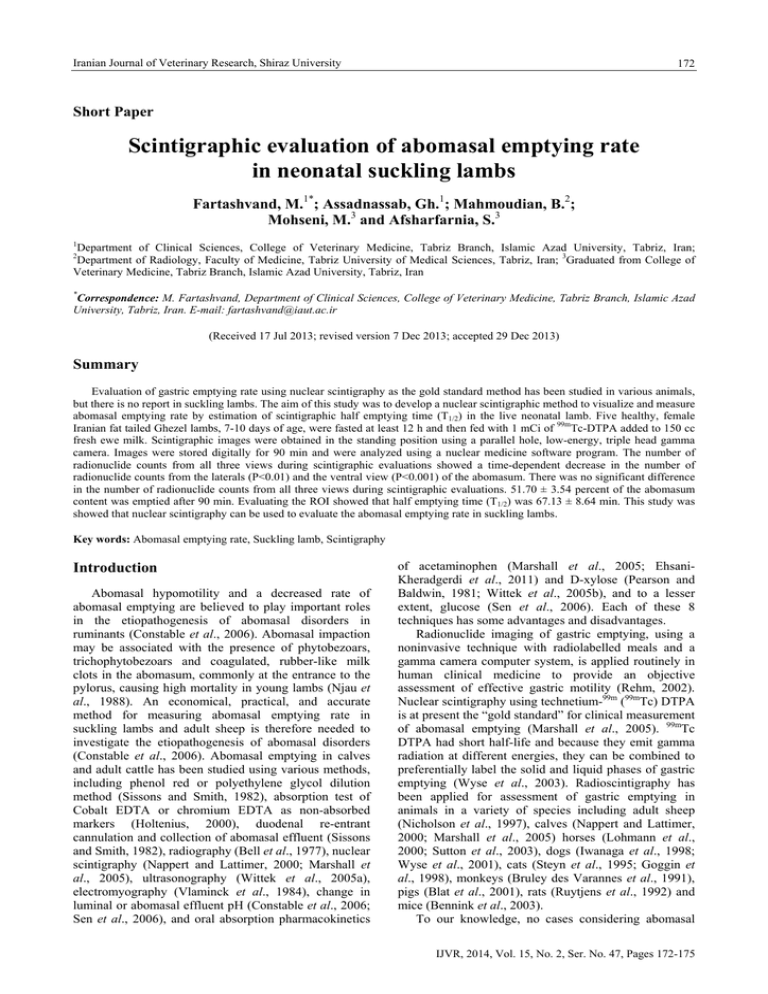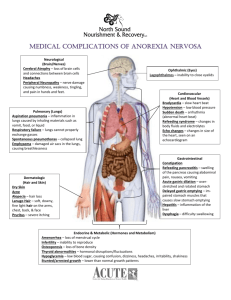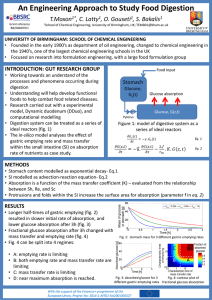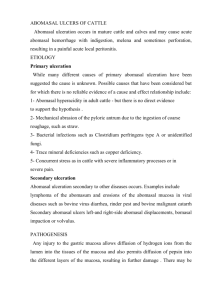- Iranian Journal of Veterinary Research
advertisement

Iranian Journal of Veterinary Research, Shiraz University 172 Short Paper Scintigraphic evaluation of abomasal emptying rate in neonatal suckling lambs Fartashvand, M.1*; Assadnassab, Gh.1; Mahmoudian, B.2; Mohseni, M.3 and Afsharfarnia, S.3 1 Department of Clinical Sciences, College of Veterinary Medicine, Tabriz Branch, Islamic Azad University, Tabriz, Iran; Department of Radiology, Faculty of Medicine, Tabriz University of Medical Sciences, Tabriz, Iran; 3Graduated from College of Veterinary Medicine, Tabriz Branch, Islamic Azad University, Tabriz, Iran 2 * Correspondence: M. Fartashvand, Department of Clinical Sciences, College of Veterinary Medicine, Tabriz Branch, Islamic Azad University, Tabriz, Iran. E-mail: fartashvand@iaut.ac.ir (Received 17 Jul 2013; revised version 7 Dec 2013; accepted 29 Dec 2013) Summary Evaluation of gastric emptying rate using nuclear scintigraphy as the gold standard method has been studied in various animals, but there is no report in suckling lambs. The aim of this study was to develop a nuclear scintigraphic method to visualize and measure abomasal emptying rate by estimation of scintigraphic half emptying time (T1/2) in the live neonatal lamb. Five healthy, female Iranian fat tailed Ghezel lambs, 7-10 days of age, were fasted at least 12 h and then fed with 1 mCi of 99mTc-DTPA added to 150 cc fresh ewe milk. Scintigraphic images were obtained in the standing position using a parallel hole, low-energy, triple head gamma camera. Images were stored digitally for 90 min and were analyzed using a nuclear medicine software program. The number of radionuclide counts from all three views during scintigraphic evaluations showed a time-dependent decrease in the number of radionuclide counts from the laterals (P<0.01) and the ventral view (P<0.001) of the abomasum. There was no significant difference in the number of radionuclide counts from all three views during scintigraphic evaluations. 51.70 ± 3.54 percent of the abomasum content was emptied after 90 min. Evaluating the ROI showed that half emptying time (T1/2) was 67.13 ± 8.64 min. This study was showed that nuclear scintigraphy can be used to evaluate the abomasal emptying rate in suckling lambs. Key words: Abomasal emptying rate, Suckling lamb, Scintigraphy Introduction Abomasal hypomotility and a decreased rate of abomasal emptying are believed to play important roles in the etiopathogenesis of abomasal disorders in ruminants (Constable et al., 2006). Abomasal impaction may be associated with the presence of phytobezoars, trichophytobezoars and coagulated, rubber-like milk clots in the abomasum, commonly at the entrance to the pylorus, causing high mortality in young lambs (Njau et al., 1988). An economical, practical, and accurate method for measuring abomasal emptying rate in suckling lambs and adult sheep is therefore needed to investigate the etiopathogenesis of abomasal disorders (Constable et al., 2006). Abomasal emptying in calves and adult cattle has been studied using various methods, including phenol red or polyethylene glycol dilution method (Sissons and Smith, 1982), absorption test of Cobalt EDTA or chromium EDTA as non-absorbed markers (Holtenius, 2000), duodenal re-entrant cannulation and collection of abomasal effluent (Sissons and Smith, 1982), radiography (Bell et al., 1977), nuclear scintigraphy (Nappert and Lattimer, 2000; Marshall et al., 2005), ultrasonography (Wittek et al., 2005a), electromyography (Vlaminck et al., 1984), change in luminal or abomasal effluent pH (Constable et al., 2006; Sen et al., 2006), and oral absorption pharmacokinetics of acetaminophen (Marshall et al., 2005; EhsaniKheradgerdi et al., 2011) and D-xylose (Pearson and Baldwin, 1981; Wittek et al., 2005b), and to a lesser extent, glucose (Sen et al., 2006). Each of these 8 techniques has some advantages and disadvantages. Radionuclide imaging of gastric emptying, using a noninvasive technique with radiolabelled meals and a gamma camera computer system, is applied routinely in human clinical medicine to provide an objective assessment of effective gastric motility (Rehm, 2002). Nuclear scintigraphy using technetium-99m (99mTc) DTPA is at present the “gold standard” for clinical measurement of abomasal emptying (Marshall et al., 2005). 99mTc DTPA had short half-life and because they emit gamma radiation at different energies, they can be combined to preferentially label the solid and liquid phases of gastric emptying (Wyse et al., 2003). Radioscintigraphy has been applied for assessment of gastric emptying in animals in a variety of species including adult sheep (Nicholson et al., 1997), calves (Nappert and Lattimer, 2000; Marshall et al., 2005) horses (Lohmann et al., 2000; Sutton et al., 2003), dogs (Iwanaga et al., 1998; Wyse et al., 2001), cats (Steyn et al., 1995; Goggin et al., 1998), monkeys (Bruley des Varannes et al., 1991), pigs (Blat et al., 2001), rats (Ruytjens et al., 1992) and mice (Bennink et al., 2003). To our knowledge, no cases considering abomasal IJVR, 2014, Vol. 15, No. 2, Ser. No. 47, Pages 172-175 Iranian Journal of Veterinary Research, Shiraz University 173 emptying rate in lamb have been reported. The aim of the present study was to develop a nuclear scintigraphy method to visualize and measure abomasal emptying rate by estimation of scintigraphic half emptying time (T1/2) in the living neonatal lamb. Materials and Methods Animals The experimental protocol was approved by the Institutional Animal Care and use committee of the Veterinary Faculty of the Islamic Azad University of Tabriz. Five healthy, female Iranian fat-tailed Ghezel lamb were obtained from the Islamic Azad University of Tabriz. Lambs at the time of experiments were between 7 and 10 days of age and were kept unrestrained with their mothers and were fed freely, but at least 12 h were separated from their mothers. At the beginning of the study period, each lamb was weighed and placed in a movable wooden restrainer that prevented her movement. Abomasal emptying rate was measured by scintigraphic procedure. For all experiments, time of day, the room and equipment used and the people conducting the experiment were the same. Procedure and instrumentation The scintigraphic evaluations of abomasal emptying were carried out using the same method for small animals (Wyse et al., 2003) and calves (Nappert and Lattimer, 2000) with slight modifications. The lambs were fed with 1 mCi of technetium Tc99mdiethylenetriamine-penta acetic acid (99mTc-DTPA) added to 150 cc fresh ewe milk. Immediately following administration of the 99mTc-DTPA containing milk, the lambs were placed in the restrainer in the standing position and imaged with the triple head gamma camera. Scintigraphic images were obtained on a large field-ofview gamma camera fitted with parallel hole, lowenergy, all-purpose collimators (IRIX, Marconi Medical System Inc., Cleveland, Ohio, USA) that were positioned for acquisition of ventral and right and left lateral images. The positioning centered the abomasum on the imaging field. All images were obtained in a dynamic series during suckling to assist in identifying the anatomic location of the abomasum and to monitor the route of the suckled fluid, thereby monitoring the esophagus. Radionuclide counts were collected each 15 sec for 90 min using a 128 × 128 matrix and magnification with 1.33 zoom factor. No sedative or any anticholinergic medication was administered to the lambs. Analysis Images were stored digitally by interfacing the camera to a computer via a dedicated analog-to-digital data converter. Static ventral and right and left lateral images which were analyzed by use of a nuclear medicine software program (Odyssey LX ver. 9.4; Philips Medical System, Cleveland, Ohio, USA), were used to define the abomasum as the region of interest (ROI). The ROI was drawn via two methods: 1) Automatically by use of the irregular option in the software program, thereby tracing the outline of the abomasum in an objective manner. Cinematic view of recorded images was helpful in determining the outline of the abomasum and intestine. The total number of counts in the ROI recorded for each 15-second data collection period was determined. 2) Manually, the mean number of radionuclide counts from the laterals and ventral views of the abomasum was calculated for each lamb every 10 min during scintigraphic evaluations. Data were plotted as percentage retention of radioactivity in the abomasum over time. Descriptive analysis was used to determine whether significant differences occurred between times in the radionuclide counts of the abomasum. Results Lambs remained healthy and conscious throughout the study and relatively sharp-set suckled the 150 cc of each test solution. Since the lambs were not accustomed to bottle feeding, their sucking times were slightly longer (Mean suckling time, 8.7 min; range, 5 to 16 min). The number of radionuclide counts from all three views during scintigraphic evaluations showed a timedependent decrease in the number of radionuclide counts from the lateral (P<0.01) and the ventral view (P<0.001) of the abomasum (Fig. 1). There was no significant difference in the number of radionuclide counts from all three views during scintigraphic evaluations. Retention of radioactivity in the abomasum over time (percent/min) after oral administration of the 99mTc-DTPA containing milk in the lambs was detailed in Table 1. 51.70 ± 3.54 percent of the abomasum content was emptied after 90 min. Evaluating the ROI showed that half emptying time (T1/2) was 67.13 ± 8.64 min (Figs. 2-3). Discussion Measurement of solid and liquid emptying by scintigraphy is now well established as the “gold Table 1: Retention of radioactivity in the abomasum over time after oral administration of the (percent/min) Tc-DTPA containing milk Time (min) View Left lateral Right lateral Ventral Mean±SEM 99m 0 100 100 100 100±0 10 95.99 97.59 95.05 96.21±1 20 92.87 93.22 88.98 91.69±2 30 81.75 82.20 83.70 82.55±1 IJVR, 2014, Vol. 15, No. 2, Ser. No. 47, Pages 172-175 40 74.87 76.24 78.64 75.59±2 50 71.10 70.75 69.96 70.61±1 60 70.97 62.09 64.08 65.72±4 70 56.13 59.71 56.97 57.61±2 80 54.53 56.75 51.18 54.18±2 90 50.45 50.23 44.20 48.3±3 Iranian Journal of Veterinary Research, Shiraz University 174 100 90 80 Percent 70 60 50 40 30 20 10 0 0 10 20 30 40 50 60 70 80 90 Time (min) Fig. 1: Abomasal emptying curve in lambs after oral administration of the 99mTc-DTPA containing milk Fig. 2: ROI and T1/2 in lamb No. 1 using containing milk in the ventral view 99m Tc-DTPA reported that the mean time taken to empty half the radioactivity from the abomasum was 11 min in healthy cows and 20 min in healthy goats. It is possible that these figures represented the distribution of the radioactivity within the abomasum itself, rather than true emptying, since the values were much shorter than those observed in the present study. It is determined that half emptying time for scintigraphic evaluation ranges from 29 to 202 min in suckling calves (Marshall et al., 2005). The wide spectrum of abomasal emptying rates has been recorded in adult hay fed sheep (Nicholson et al., 1997). Although stress could delay abomasal emptying and influence the results of test, we attempted a technique that would minimize the lambs manipulation and stress. Because our study was limited to evaluating the abomasal emptying rate in a few lambs, further studies will be necessary to establish a reference range of abomasal emptying values in lambs. Although there was no significant difference in the number of radionuclide counts from all three views, right lateral view is recommended as the best view for scintigraphic evaluation of abomasum in lamb in the standing position. Due to the presence of noticeable distance between abomasum and ventral camera in standing position, the lateral views were better than ventral views. Techniques for scintigraphic evaluation of abomasal emptying in lambs have never been reported and this is the first time nuclear scintigraphy has been used to study abomasal emptying in lambs. Acknowledgements This work was done in Gamma Scan Imaging Center (Dr. B. Mahmoudian) and Veterinary Teaching Hospital, Veterinary Faculty, Islamic Azad University, Tabriz Branch, Iran. References Fig. 3: ROI and T1/2 in lamb No. 2 using containing milk in the right lateral view 99m Tc-DTPA standard“ method to evaluate gastric emptying in man (Rehm, 2002; Urbain, 2006). Radionuclide imaging allows the visualization and quantification of the passage of tracer from the abomasum with minimum invasion of the abdominal cavity (Nicholson et al., 1997). Measurement of the half emptying time (T1/2), or time required by the stomach to empty 50% of the ingested meal, is the simplest way to assess gastric transit, which is routinely and commonly used for clinical evaluation in man (Urbain, 2006). In studies of gastric emptying, imaging with a gamma camera is superior to the detection of radioactivity by a single small detector, as previously shown (Jones and Poulsen, 1974). It has been Bell, FR; Holbrooke, SE and Titchen, DA (1977). A radiological study of gastric (abomasal) emptying in calves before and after vagotomy. J. Physiol., 272: 481-493. Bennink, RJ; De Jonge, WJ; Symonds, EL; van den Wijngaard, RM; Spijkerboer, AL; Benninga, MA and Boeckxstaens, GE (2003). Validation of gastric-emptying scintigraphy of solids and liquids in mice using dedicated animal pinhole scintigraphy. J. Nuc. Med., 44: 1099-1104. Blat, S; Guérin, S; Chauvin, A; Bobillier, E; Le Cloirec, J; Bourguet, P and Malbert, CH (2001). Role of vagal innervation on intragastric distribution and emptying of liquid and semisolid meals in conscious pigs. Neurogastroenterol. Motil., 13: 73-80. Bruley des Varannes, S; Mizrahi, M and Dubois, A (1991). Relation between postprandial gastric emptying and cutaneous electrogastrogram in primates. Am. J. Physiol., 261: 248-255. Constable, PD; Wittek, T; Ahmed, AF; Marshall, TS; Sen, I and Nouri, M (2006). Abomasal pH and emptying rate in the calf and dairy cow and the effect of commonly administered therapeutic agents. Proceeding of the 24th World Buiatrics Congress. Oct. 15-19, Nice, France. PP: IJVR, 2014, Vol. 15, No. 2, Ser. No. 47, Pages 172-175 175 54-68. Ehsani-Kheradgerdi, A; Sharifi, K; Mohri, M and Grünberg, W (2011). Evaluation of a modified acetaminophen absorption test to estimate the abomasal emptying rate in Holstein-Friesian heifers. Am. J. Vet. Res., 72: 1600-1606. Goggin, JM; Hoskinson, JJ; Butine, MD; Foster, LA and Myers, NC (1998). Scintigraphic assessment of gastric emptying of canned and dry diets in healthy cats. Am. J. Vet. Res., 59: 388-392. Holtenius, K; Sternbauer, K and Holtenius, P (2000). The effect of the plasma glucose level on the abomasal function in dairy cows. J. Anim. Sci., 78: 1930-1935. Iwanaga, Y; Wen, J; Thollander, MS; Kost, LJ; Thomforde, GM; Allen, RG and Phillips, SF (1998). Scintigraphic measurement of regional gastrointestinal transit in the dog. Am. J. Physiol., 275: 904-910. Jones, BEV and Poulsen, JSD (1974). Abomasal emptying rates in goats and cows measured by external counting of radioactive sodium chromate injection directly to the abomasum. Nord. Vet. Med., 26: 13-21. Lohmann, KL; Roussel, AJ; Cohen, ND; Boothe, DM; Rakestraw, PC and Walker, MA (2000). Comparison of nuclear scintigraphy and acetaminophen absorption as a means of studying gastric emptying in horses. Am. J. Vet. Res., 61: 310-315. Marshall, TS; Constable, PD; Crochik, SS and Wittek, T (2005). Determination of abomasal emptying rate in suckling calves by use of nuclear scintigraphy and acetaminophen absorption. Am. J. Vet. Res., 66: 364-374. Nappert, G and Lattimer, GC (2000). Comparison of abomasal emptying in neonatal calves with a nuclear scintigraphic procedure. Can. J. Vet. Res., 65: 50-54. Nicholson, T; Stockdale, HR; Critchley, M; Grime, JS; Jones, RS and Maltby, P (1997). Radionuclide imaging of abomasal emptying in sheep. Res. Vet. Sci., 62: 26-29. Njau, BC; Kasali, OB and Scholtens, RG (1988). Abomasal impaction associated with anorexia and mortality in lambs. Vet. Res. Commun., 12: 491-495. Pearson, EG and Baldwin, BH (1981). D-Xylose absorption in the adult bovine. Cornell Vet., 71: 288-296. Rehm, PK (2002). Scintigraphic evaluation of gastric emptying. Appl. Radiol., 31: 26-32. Ruytjens, I; Thomforde, GM; Camilleri, M and Chapman, IJVR, 2014, Vol. 15, No. 2, Ser. No. 47, Pages 172-175 Iranian Journal of Veterinary Research, Shiraz University NJ (1992). Effect of chemical sympathectomy on scintigraphic gastric and small bowel transit in the rat. J. Auton. Nerv. Syst., 39: 111-117. Sen, I; Constable, PD and Marshall, TS (2006). Effect of suckling isotonic or hypertonic solutions of sodium bicarbonate or glucose on abomasal emptying rate in calves. Am. J. Vet. Res., 67: 1377-1384. Sissons, JW and Smith, RH (1982). Effect of duodenal cannulation on abomasal emptying and secretion in the preruminant calf. J. Physiol., 322: 409-417. Steyn, PF; Twedt, DT and Toombs, W (1995). The scintigraphic evaluation of solid phase gastric emptying in normal cats. Vet. Radiol. Ultrasound. 36: 327-331. Sutton, DG; Bahr, A; Preston, T; Christley, RM; Love, S and Roussel, AJ (2003). Equine gastric motility: validation of the 13C-octanoic acid breath test for measurement of gastric emptying rate of solids using radioscintigraphy. Equine Vet. J., 35: 27-33. Urbain, JLCP (2006). Gastric emptying scintigraphy. In: Schiepers, C; Leuven, ALB and Heidelberg, KS (Eds.), Diagnostic nuclear medicine. (2nd Edn.), Berlin Heidelberg, Springer-Verlag. PP: 128-131. Vlaminck, K; Van Den Hende, C; Oyaert, W and Muylle, E (1984). Studies on abomasal emptying in cattle. I. Correlation between abomasal emptying, electromyographic activity and pressure changes in the abomasaum. Zentralbl. Veterinarmed. A., 31: 561-566. Wittek, T; Constable, PD; Marshall, TS and Crochik, SS (2005a). Ultrasonographic measurement of abomasal volume, location, and emptying rate in calves. Am. J. Vet. Res., 66: 537-544. Wittek, T; Schreiber, K; Fürll, M and Constable, PD (2005b). Use of the D-xylose absorption test to measure abomasal emptying rate in healthy lactating HolsteinFriesian cows and in cows with left displaced abomasum or abomasal volvulus. J. Vet. Intern. Med., 19: 905-913. Wyse, CA; McLellan, J; Dickie, AM; Sutton, DG; Preston, T and Yam, PS (2003). A review of methods for assessment of the rate of gastricemptying in the dog and cat: 1898-2002. J. Vet. Intern. Med., 17: 609-621. Wyse, CA; Preston, T; Love, S; Morrison, DJ; Cooper, JM and Yam, PS (2001). The 13C-octanoic acid breath test for assessment of solid phase gastric emptying in dogs. Am. J. Vet. Res., 62: 1939-1944.





